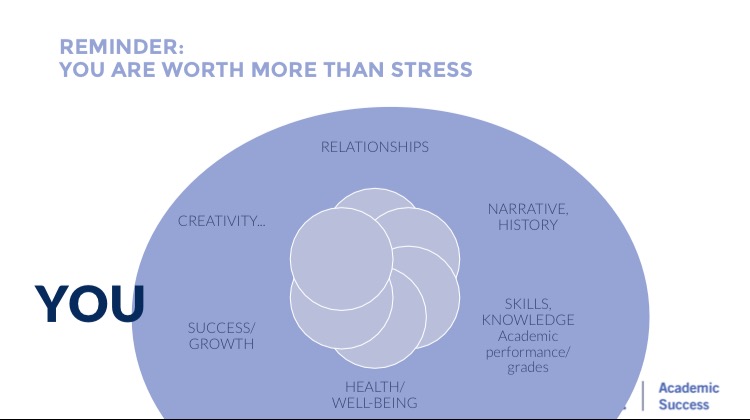We are here with part two of Life Over Stress! When I attended the Resilience and Time Management workshop held by Academic Success, we went through many different ways to physically and mentally take care of ourselves through the trying time of school and just through life in general.
Maintaining proper eating habits, sleeping habits and body movement were just some of the physical components that we need to keep our bodies in tip-top shape. Then, when you add on mental and emotional wellness techniques such as meditation, mindfulness and goal setting, and everything can seem a little overwhelming. But the thing to keep in mind is that you can add new ways of coping to your routine as you need them, building towards a long-term goal.
Throughout the years I have learned a few techniques to help focus my mind if I am getting overwhelmed. For instance, I’ve tried box breathing (where you inhale and exhale following the lines of a box), and pouring super-cold water on my wrists, face or in a shower to shock my body out of a panic.
I've tried out a lot of methods in the past, but one that was new to me was a somatic practice called emotional freedom technique (EFT), or “tapping”. EFT combines tapping specific points on our body (forehead, temples, above the mouth, etc.; see diagram) while verbalizing either mentally or out loud any stressful or difficult thoughts we’re having, before moving on to more-positive thoughts. It sounds simple, but studies have shown tapping can decrease stress hormones more than talk therapy and that it can help in treatment even of clinical conditions like post-traumatic stress
The process starts with tapping a few times first on the side of the hand (“karate chop point”), while acknowledging challenging circumstances or negative feelings; while we tap, we also verbalize self-acceptance, for example: “Even though I’m feeling incredibly stressed and worried, I accept that this is how I am feeling right now and that that’s okay”. Even if we don’t feel it’s okay at that moment, we proceed with this “setup” statement anyway, as a way of bringing some tactile experience to negative thoughts we normally run unquestioningly in our minds
Then you continue to tap on various points on the body in a particular sequence (again, have a look at the diagram), focusing first on negative thoughts and saying them out loud or to ourselves at each tapping point. Gradually, we then shift away from the negative thoughts and begin to be kinder to ourselves: we start off tapping with statements like, “I feel like a failure and there’s no way I can do well enough on finals” to “I am having a hard week and that’s okay. I can be proud of myself for all that I have done this, no matter how small it might seem.” The technique is a way of being kinder to ourselves, combining a way to think more positively while we make our bodies feel better, allowing us to create a different relationship with positivity.
I found that being able to hear myself be positive and kind to myself made me realize how often I would disregard my internal positivity and allow the negative thoughts to flow. Vocalizing self-accepting thoughts allowed me to accept acts of kindness to myself and to be more willing to show kindness to others.
Obviously one workshop on this technique doesn’t make me a master, and I encourage you all to look into workshops on campus or videos online to try and take of yourself! The winter season with its long nights and gloomy days is taxing on our mind and body.
Listen to your body: it knows more about you than you think! Be kind to yourself and be proud of what you've done.
Below is the link to some slides on stress management from the "Stress Management" workshop. If you have questions about stress management, don’t forget to use the resources available—workshops by Academic Success, Health and Wellness, and your colleges and faculties across campus (including drop-in stress-counselling sessions at Robarts during the final weeks of semester). You can also find some tips on stress management from selected slides from that workshop here.
Robarts_Stress_Management_FOR BLOG

0 comments on “Life Over Stress Part 2”